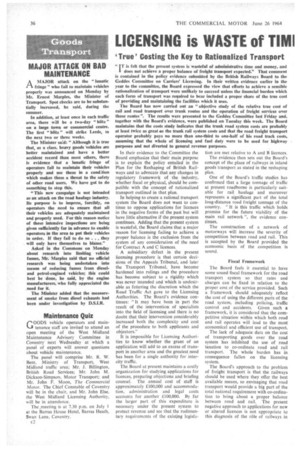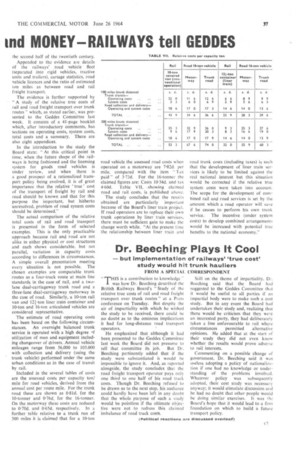LICENSING is WASTE of TIMI tnd MONEY—RAILWAYS tell GEDDES
Page 38

Page 39

If you've noticed an error in this article please click here to report it so we can fix it.
True' Costing the Key to Rationalized Transport
" IT is felt that the present system is wasteful of administrative time and money, and 1 does not achieve a proper balance of freight transport expected." That comment is contained in the policy evidence submitted by the British Railways Board to the Geddes Committee on Carriers' Licensing. In their written evidence earlier in the year to the committee, the Board expressed the view that efforts to achieve a sensible rationalization of transport were unlikely to succeed unless the financial burden which each form of transport was required to bear included a proper share of the true cost of providing and maintaining the facilities which it uses.
The Board has now carried out an "objective study of the relative true cost of rail and road transport over trunk routes and the operation of freight services over those routes ". The results were presented to the Geddes Committee last Friday and, together with the Board's evidence, were published on Tuesday this week. The Board maintains that the costs study indicates that the trunk road system costs are probably at least twice as great .as the trunk rail system costs and that the road freight transport operator probably pays no more than one-third to one-half of his road track costs, assuming that the whole of licensing and fuel duty were to be used for highway purposes and not diverted to general revenue purposes.
In their evidence to the Committee the Board emphasize that their main purpose is to explain the policy entailed in the Plan for the Reshaping of British Railways and to advocate that any changes in regulatory framework of the industry, whether fiscal or physical, should be compatible with the concept of rationalized transport outlined in that plan.
In helping to create a rational transport system the Board does not want to continue to oppose applications for licences in the negative forms of the past but will have little alternative if the present system continues. Adding that the present system is wasteful, the Board claims that a major reason for licensing failing to achieve a proper balance is the exclusion from the system of any consideration of the need for Contract A and C licences.
A subsidiary defect in the present licensing procedure is that certain decisions of the Appeals Tribunal, and later the Transport Tribunal, have become hardened into rulings and the procedure has become subject to a rigidity which was never intended and which is undesirable as fettering the discretion which the Road Traffic Act gave to the Licensing Authorities. The Board's evidence continues: "It may have been in part the result of the intervention of specialists into the field of licensing and there is no doubt that their intervention considerably increased both the complexity and cost of the procedure to both applicants and objectors."
It is impossible for Licensing Authorities to know whether the grant of an application. will add to an excess of transport in another area and the greatest need has been for a single authority for intercity traffic.
The Board at present maintains a costly organization for studying applications for licences, preparingobjections and briefing counsel. The annual cost of staff is approximately £100,000 and accommodation, administration and legal costs accounts for another £100,000. By far the larger part of this expenditure is necessary under the present system to protect revenue and see that the rudimentary requirements of the existing legisla
tion are met relative to A and B licences.
The evidence then sets out the Board's concept of the place of railways in inland goods transport as stated in the reshaping plan.
One of the Board's traffic studies has confirmed that a large tonnage of traffic at present roadborne is particularly suitable for rail haulage and moreover represents a significant part of the total long-distance road freight tonnage of the country. "It is this traffic which holds promise for the future viability of the main rail network ", the evidence continues.
The construction of a network of motorways will increase the severity of competition between road and rail. This is accepted by the Board provided the economic basis of the competition is sound.
Fiscal Framework The Board feels it essential to have some sound fiscal framework for the road transport system so that rates and charges can be fixed in relation to the proper cost of the service provided. Such a framework should adequately reflect the cost of using the different parts of the road system, including policing, traffic control and accidents. Given such a framework, it is considered that the competitive situation within which both road and rail operates will lead to the most economical and efficient use of transport.
The lack of adequate data on the cost of transporting goods over the road system has inhibited the use of road taxation to co-ordinate road and rail transport. The whole burden has in consequence fallen on the licensing system.
The Board's approach to the problem of freight transport is that the railways should be used where they offer the best available means, so envisaging that road transport would provide a big part of the total national requirement with co-ordination to bring about a proper balance between road and rail. _ The present negative approach to applications for new or altered licences is not appropriate to this diagnosis of the role of railways in the second half of the twentieth century.
Appended to the evidence are details of the railways' road vehicle fleet (separated into rigid vehicles, tractive units and trailers), cartage statistics, road vehicle licences and the ratio of estimated ton miles as between road and rail freight transport.
The evidence is further supported by " A study of the relative true costs of rail and road freight transport over trunk routes" which, as stated earlier, was presented to the Geddes Committee last week. It consists of a 41-page booklet which, after introductory comments, has sections on operating costs, system costs, total costs and a summary. There are also eight appendices.
In the introduction to the study the Board state; " At this critical point in time, when the future shape of the railways is being fashioned and the licensing system for goods road vehicles is under review, and when there is a good prospect of a rationalized transport policy being evolved, it is of great importance that the relative ' true ' cost of the transport of freight by rail and road should be known and that for this purpose the important, but hitherto unresolved, problem of road system costs should be determined."
The actual comparison of the relative total costs of rail and road transport is presented in the form of selected examples. This is the only practicable approach because rail and road are not alike in either physical or cost structures and each shows considerable, but not parallel, variation in capacity costs according to differences in circumstances. A simple overall presentation meeting every situation is not possible. The chosen examples are comparable trunk routes as a four-track route at main line standards in the case of rail, and a twolane dual-carriageway trunk road and a three-lane dual-carriageway motorway in the case of road. Similarly, a 10-ton rail van and 124-ton liner train container and 10-ton and 16-ton articulated vehicles are considered representative.
The estimate of road operating costs has been based on the following circumstances. An overnight balanced trunk service is operated with a high degree af utilization of men and equipment including changeover of drivers. Annual vehicle mileages range from 56,000 to 103.000 with collection and delivery (using the trunk vehicle) performed under the same urban conditions as in the case of transit by rail.
Included in the several tables of costs are the assessed costs per capacity ton/ mile for road vehicles, derived from the annual cost per route mile. For the trunk road these are shown as 0.81d. for the JO-tonner and 0-76d. for the 16-tonner. On the motorway these costs are reduced to 0-70d. and 0.65d. respectively. In a further table relative to a trunk run of 300 miles it is claimed that for a 10-ton road vehicle the assessed road costs when operated on a motorway are 7-02d. per mile, compared with the item Tax paid" of 3-73d. For the 16-tonner the claimed figures are; Costs 10.34d. and tax 4.60d, Table VII, -showing claimed road and rail costs, is published above.
The study concludes that the results obtained are particularly important because of the .Board's liner train project. If road operators are to replace their own trunk operations by liner train services, there must be sufficient gain to make the change worth while. "At the present time the relationship between liner train and
road trunk costs (including taxes) is such that the development of liner train services is likely to be limited against the real national interest but this situation would be corrected if the relative true system costs were taken into account. The scope for the development of combined rail and road services is set by the amount which a road operator will save if he ceases to perform his own trunk service. The incentive (under system costs) to develop combined arrangements would be increased with potential true benefits to the national economy."




























































































































